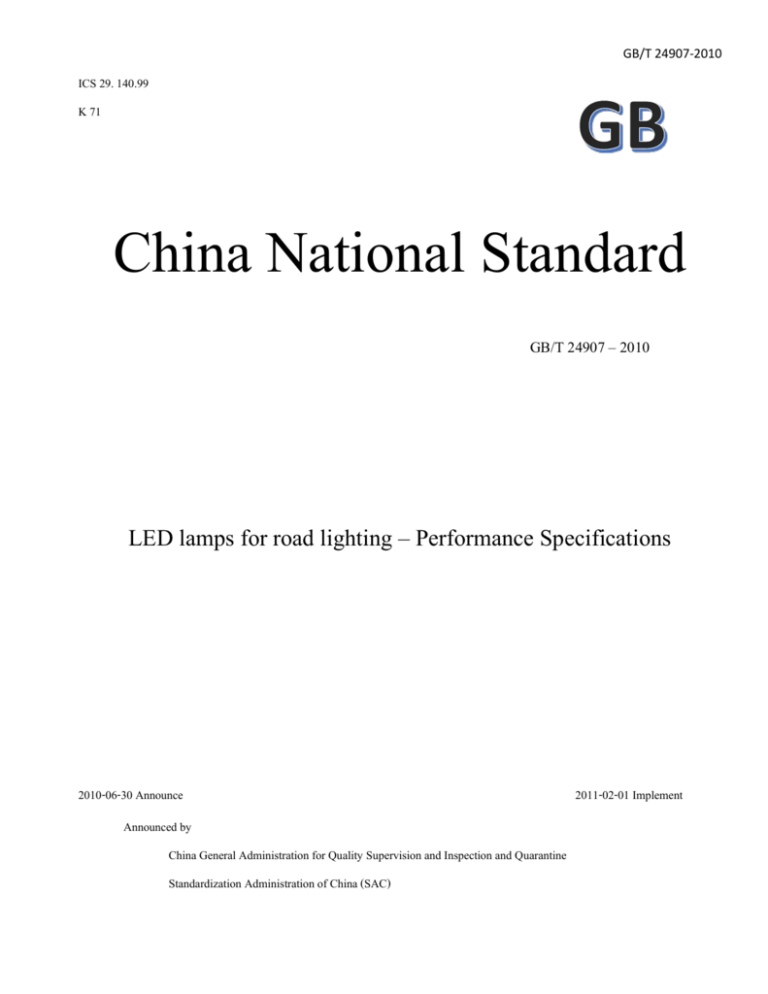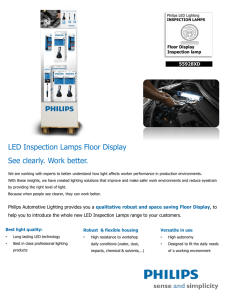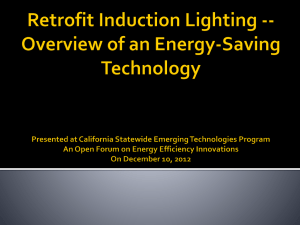GB - NSTDA
advertisement

GB/T 24907-2010 ICS 29. 140.99 K 71 China National Standard GB/T 24907 – 2010 LED lamps for road lighting – Performance Specifications 2010-06-30 Announce Announced by China General Administration for Quality Supervision and Inspection and Quarantine Standardization Administration of China (SAC) 2011-02-01 Implement GB/T 24907-2010 Contents Page Foreword II 1 Standard Scope 1 2 References 1 3 Terms and Definitions 2 4 Classification and Naming 2 5Technical Requirement 3 6 Testing Method 4 7 Inspection Regulation 5 8 Marking, Packaging, Transport and Storage 7 Appendix A (Material Information): Light intensity distribution requirement of rectangle lamp spot light 9 Appendix B (Material Information): Lamp Durability and Testing Method 10 I GB/T 24907-2010 Foreword Appendix A and B in this standard are material information. This standard is proposed by China Federation of Industrial Economics. This standard is centralized by National Lighting Appliance Standardization Technical Committees (SAC/TC 224). This standard is drafted by following organizations; Hangzhou MC2 Lighting Ltd., Dongguan Kingsun Optoelectronic Co.,Ltd.,MIG Technology Inc., Tianjin Zhonghuan Huaxing Electronic Co.,Ltd., Shanghai Yaming Lighting Co.,Ltd., Jiangsu Civil and Industrial Mining Lamp product Testing Center, Tongxiang Shenghui Lighting Electrical Co.,Ltd., Zhongshan Huayi Lighting Optoelectronic Co.,Ltd., Nanjing Handson Co.,Ltd., Dongguan Keruide Digital photoelectric S&T Co.,Ltd., Jiangsu YASHIPS Lighting Co.,Ltd., Shanxi Guangyu Power Sources Co.,Ltd., Zhejiang Qiushi Information electronics Co.,Ltd., Beijing ZhongAnWuXian Technology Co.,Ltd., Shenzhen Bang-Bell Electronics Co.,Ltd., Xi'an Liming Electronic Technology Co.,Ltd., Zhejiang Guyue Longshan Electric Technology Development Co.,Ltd., HB Technology Cast Group, Sky Resources Solar (group) Co.,Ltd., Hangzhou Everfine Photo-E-Info Co.,Ltd., Dalian Jiujiu Light Electricity Co.,Ltd., Neo-Neon LED Light International Ltd. This standard is formulated by following people; Chen Zhegen, Yan Qianjun, Li Xuliang, Wang Ping, Shao Kang, Yan Huafeng, Yang Yuhua, Shen Jinxiang, Peng Zhaofu, Zhou Ming, Ma Shuai, Yin Jinxiang, Xu Fugui, Xu Zhihua, Lin Qinghong, He Lin, Mu Yijing, Ding Shendong, Hu Bing, Lei Zongping, Pan Jiangen, Yang Jinghua, Zhu Bingzhong, Liu Changle, Jiang Zengpin, and Tao Jiuxiang. II GB/T 24907-2010 LED lamps for road lighting – Performance Specifications 1 Standard Scope This standard has been formulated the terms and definitions, the type and name, the technical requirement, testing method, inspection regulation, marking, packaging, transportation and storage of LED lamps for road lighting. This standard is used for LED device, gather with control device circuit and lamp device. Alternative current with 220V/50Hz is used for "LED lamps for road lighting", which is abbreviated as "lamp". The lamp, which is complied with this standard, should be able to operate with 92%-106% rated voltage in temperature range 30°C-45°C. 2 References The subtopics in document list below are already quoted as subtopics of this standard. For dated documents, the later revised version with any condition are not complied with this standard, however, for encouraging various studies, base on agreement of this standard, it’s able to use the latest version of these documents. For undated documents, the latest version is complied with this standard. GB/T 2828.1 Sampling procedures for inspection by attributes-Part1: Sampling schemes indexed by acceptance quality limit (AQL) for lot-by-lot inspection (GB/T 2828.1 – 2003, ISO 2859-1: 1999, IDT) GB/T 2829 Sampling procedures and table for periodic inspection by attributes (Apply to inspection of process stability) GB/T 10682 Double-ended fluorescent lamps - Performance requirements GB 17625.1 Electromagnetic compatibility - limits - limits for harmonic current emissions (equipment input current <= 16A per phase) (GB 17625.1 – 2003, IEC 61000-3-2:2001, IDT) GB 17743 Limits and methods of measurement of radio disturbance characteristics of electrical lighting and similar equipment (GB 17743 – 2007, CISPR 15:2005+A1:2006, IDT) GB/T 18595 For general lighting purpose -EMC immunity requirements (GB/T 18595 – 2001, idt IEC 61547:1995) GB 24819 LED modules for general lighting - Safety specification GB/T 24823 LED modules for general lighting - Performance requirement 1 GB/T 24907-2010 GB/T 24824 Measurement methods of LED Modules for general lighting CJJ 45 Standard for lighting design of urban road 3 Terms and Definitions GB/T 24823 has established by the following terms and definitions, which suits for this standard. LED lamp for road lighting To meet the road lighting requirement of LED lighting device assembly and installation, there is the combination of light resource and other devices; Light Emitting Diode(LED) as light resource; other lamp part includes optic part, machine part, electric part and electronic part. Every part assemble as one body. 4 Classification and Naming 4.1 Type 4.1.1 According to rated wattage, it could be divided as following: 20W, 30W, 45W, 60W, 75 W, 90W, 120W, 160W, 180W, 200W, 250W, and 300W etc. 4.1.2 According to the different light distribution types with many light forms on road, it could be divided as rectangle LED spot light (code name as "J"), circular or ellipse spot light (code name as "Y"). 4.1.3 According to dimming type, it could be divided as dimming LED light (code name as "T") and non-dimming LED light (code name as "F"). 4.1.4 According to power of LED component, it could be divided by 0.5W; smaller than 0.5Wof LED components combined as LED lamp (code name as "X"), another type is combined LED components' wattage is greater than or equals to 0.5W (code name as "G"). 4.2 Model number compiling regulation There are five parts in lamp model number; first part represents lamp code name (BDZ represents "LED lamps for road lighting); second part represents rated voltage and rated wattage of lamp; third part represents color tone code name; forth part represents light distribution type; fifth part is the additional information such as dimming type, LED component power type or other information. Model number illustration as following; Example: "BDZ 220/120 - RR J T" represents rated voltage at 220V, rated wattage at 120W, color tone is sunlight color with rectangle spot light, dimming LED lamps for road lighting. 2 GB/T 24907-2010 5 Technical Requirement 5.1 Safety Specifications Lamp safety specification should be complied with GB 24819 requirement. 5.2 External measurement Lamp external measurement should be complied with company regulation. 5.3 Lamp power When lamp is operating with rated electrical pressure and rated power, the different between actual consumed power and rated power should not be greater than 10%. 5.4 Power factor When lamp is operating with rated electrical pressure and rated power, the actual power factor value should not be lower than 0.05 of manufacturer nominal value. 5.5 Battery Compatibility 5.5.1 Radio disturbance characteristics of lamp should be complied with GB 17743 requirement. 5.5.2 Input current harmonics of lamp should be complied with GB 17625 requirement. 5.5.3 Battery electromagnetic immunity of lamp should be complied with GB/T 18595 requirement. 5.6 Luminosity distribution Lamp luminosity distribution should be complied with requirement of road lighting standard value CJJ 45. Manufacturing company must nominal light chopper performance, light distribution type, and light intensity value table. Remark: according to recommended luminosity distribution requirement of rectangle spot light, please see appendix A. 5.7 Initial Lighting Effect and Luminosflux There are 3 levels of initial lighting effect, as showed in table1, the actual measuring value should not be lower than the fix value in 3rd level as shown in table 1. Initial lighting luminosflux should follow the manufacturer or sale department nominal value, but the actual value should not be lower than 90% of nominal value. Table1 Level Color: RR//RZ Color: RL/RB/RN/RD 1 75 70 2 60 55 3 50 45 3 GB/T 24907-2010 5.8 Color Characteristic Chromaticity coordinates of lamp standard color should be complied with target value requirement of GB/T 10682 regulation. It is possible to make lamp non-standard color follow to customer requirement, but the target value of chromaticity coordinates of non-standard color must be given. Distance between initial read value and target value of chromaticity coordinates x and y should be smaller than 8 SDCM (standard deviation of color matching). Initial rated value of lamp color rendering index is 70, the actual value of 3 numerical values should not be lower than this value. 5.9 Average life expectancy The average life expectancy of lamp should not be less than 20000 hours. 5.10 Lumen maintenance At 3000 hours operation, the lumen maintenance should not be lower than 90%; while at 6000 hours operation, the lumen maintenance should not be lower than 85%. 5.11 On-Off times counting When exert the rated input voltage, then open the lamp for 60 seconds, and close it for 60 seconds, the lamp should be open and close reach 5000 times. Remark: manufacturer could be able to use recommend method in appendix B to implement the lamp durability testing. 6 Testing Method 6.1 General Requirement of Testing Except there is another fix condition, all test circumstance temperature should be around 25◦C+1◦C, and must be processed under the condition of greatest relative temperature at 65% with circumstance of no convective wind. The supply voltage should be maintained in range of +0.5% during stable period, and it should drop to range of +0.2% in testing period. In life expectancy test, the supply voltage should be maintained in range of +2%. The harmonic content of supply voltage should not be greater than 3%. Total harmonic content is the summation of root mean square of fundamental wave at 100% secondary harmonic component. Every testing should be processed under rated frequency, and lamp should be placed in free space. 6.2 External Measurement Test The error of external measurement (5.2) test should not be greater than 0.5 mm of gauging of measuring device. 6.3 Fundamental electric performance test 4 GB/T 24907-2010 The lamp power (5.3) and power factor (5.4) should be processed by testing method of GB/T 24824 regulation. 6.4 Battery Compatibility Lamp radio disturbance characteristic (5.5.1) test should be processed under the regulation of GB 17743. Lamp input current harmonics (5.5.2) test should be processed under the regulation of GB 17625.1. Lamp battery electromagnetic immunity (5.5.3) test should be processed under the regulation of GB/T 18595. 6.5 Luminosity Performance test Testing of lamp luminosity distribution (5.6), initial lighting effect and luminosflux (5.7), and color characteristic (5.8), all should be processed by testing method of GB/T 24824 regulation. Lamp lighting results obtain from the calculator. 6.6 Average Life Expectancy Lamp average life expectancy (5.9) test should be processed by testing method of GB/T 24824. 6.7 Lumen Maintenance Lamp lumen maintenance (5.10) test should be processed by testing method of GB/T 24824 regulation. 6.8 Switch on-off times counting Lamp switch on-off times counting (5.11) test should be processed by testing method of GB/T 24824 regulation. 6.9 Marking (8.1) testing Use visual method to inspect the marking correction and marking clarity. Marking firmness degree is inspected by using dipping water cloth to clean the mark for 15 seconds, then use dipping organic solvent (hexane) cloth wipe on product mark for 15 seconds. After test, the mark must still be clear. 7 Inspection Regulation 7.1 For proving the lamp, whether it is follow to the requirement of this standard, the manufacturers should process the company products acceptance inspection and routine inspection. 7.2 Acceptance Inspection 7.2.1 Lamp acceptance inspection is selected from the qualified submitted lamp batch by random, follows to GB/T 2828.1 regulation. The inspection level and the inspection quality level should be complied with the regulation which is shown in table 2. 5 GB/T 24907-2010 7.2.2 If the acceptance inspection is not passed, then this lamp batch should be processed all tests again after separating by manufacturing plant. After rejecting the unqualified product, it is allowed to submit to do the inspection again. If the submitting batch is still not qualified, then should not resubmit this batch, also, do the root cause analysis and propose the product improving step and handling method of unqualified product batch. Table 2 Acceptance Inspection Topic and qualified determination condition Mechanical Testing Sampling Inspection Dimension Inspection topic AQL/% requirement method method level 1 Marking 8.1 6.9 S-3 4.0 2 Dimension 5.2 6.2 3 Lamp power 5.3 6.3 once Power factor 4 5.4 S-2 6.5 Initial lighting effect 5 and luminouseflux 5.7 6.5 6 Color characteristic 5.8 7.3 Routine Inspection 7.3.1 Routine Inspection period should process at least one time every year. When there are changes of lamp structure, industrial process, or materials, which could be able to affect to lamp performance, or the product line had been stopped for more than six months and restarted. With all conditions, the routine inspection should be processed again. 7.3.2 Routine inspection of product should be complied with GB/T 2829 requirement; the chosen sample is from the qualified lamp by random. Before routine inspection, every sample should be overall inspected the acceptance inspection. If there are some unqualified samples, it should be changed to the qualified one. Also, do the root cause analysis and record in the inspection report. But do not use as lamp identification basis. Routine inspection topic and determining level should be complied with regulation which shown in table 3. 7.3.3 If sample do not pass the routine inspection that means this lamp batch is also not qualified. Next, should do root cause analysis, propose the handling method with appropriate step, then restore this lamp batch to manufacturer for verifying and accepting. 6 GB/T 24907-2010 Table 3 Routine Inspection Topic and Determining level No. Inspection topic Mechanical requirement 1 2 3 Luminous intensity Battery compatibility Lumen Maintenance On-Off time counting Average life expectancy 5.6 5.5 5.10 5.11 5.9 4 5 Testing Sampling Determine RQL method method level 6.5 6.4 6.7 6.8 6.9 n Determine value Ac Re once II 65 5 1 2 twice II 65 3 3 0 1 2 2 For all specification are not less than 3, following to definition. 8 Marking, Packaging, Transport and Storage 8.1 Every lamp surface mark should be clear and firm, with the following conditions; a.) Manufacturer name or product trade mark; b.) Electrical resource voltage and frequency; c.) Using power, model number, or light or electric parameter (propose by manufacturing company or sale department); d.) Manufacturing date (year, period or month) Remark: year and month are indicated by using number, while period is indicated by Latin alphabet. 8.2 Lamp should be packed in packaging box. Packaging box should be safe and reliable, and contains product certificate of conformity inside the box or covered by conformity stamp, follow 8.3 requirement. 8.3 Product certificated of conformity should indicate the followings; a.) Manufacturer name,product trade mark; b.) Inspection date; c.) Inspector signature. 8.4 Packaging box should clearly indicate by Chinese character: a.) Manufacturer name, product trade mark, or manufacturer address; b.) Product name and symbol; c.) Rated voltage and frequency; d.) Quantity of lamp in packaging box; e.) Product standard number; f.) Other 7 GB/T 24907-2010 8.5 Lamp should be storage in the place that the humidity level is not greater than 85% of ventilated room, and there should not be the corrosive gas in storage. 8.6 In progress of transportation, lamp should be avoid from rain and show, and the extreme mechanical vibration. 8 GB/T 24907-2010 Appendix A (Material Information) Light intensity distribution requirement of rectangle lamp spot light According to light intensity distribution of conventional road lighting (see CJJ 45 standard definition) of rectangle spot light LED lamp for road lighting, the recommend 4 directions of coordination system of light intensity (C=25◦, r=62◦), (C=155◦,r=62◦), (C=185◦,r=60◦), (C=355◦,r=60◦), all correspondence in range of 4 pyramid solid angles. Light intensity is large as 150 cd/klm; Uniformity of road surface illuminance with reduced luminous intensity will be at 0.4. Therefore, road surface illuminance with reduced luminous intensity Iz(c,r) as follow; I(c,r) refers to the actual luminous intensity of (c,r) direction. Road surface illuminance with reduced luminous intensity refers to; At certain lighting solid angle, lamp will be at specific value between the minimum value of random direction and average value of all directions of reduced luminous intensity. Picture A.1 C,r position in coordination system of light intensity 9 GB/T 24907-2010 Appendix B (Material Information) Lamp Durability and Testing Method Lamp durability test is recommended. Testing method is as follow: At 55+2◦C, the maximum relative temperature is 65% of no convective wind circumstance, with exerting rated voltage and after that, the operation continue for 360 hours, the lamp luminousflux should not be lower than 85% of initial luminousflux. 10 GB/T 24907-2010 People’s Republic of China (PRC) National Standard LED lamps for road lighting – Performance Specifications GB/T 24907-2010 China Normative Publishing House Beijing, Fu Xing Men Wai, San Li He Bei Jie 16th Postcode: 100045 Website: www.spc.net.cn Telephone no.: 68523946 68517548 China Normative Publishing House Qinhuangdao Printing Factory printed Xin Hua book store (Distributor) Format: 880x1230 1/16 Stamp 0.75 Characters: 16 kilowords August 2010, 1st edition / August 2010, 1st printed Document no.: 155066 .1-40195 Pricing 16.00 RMB 11



